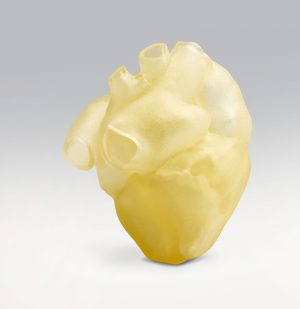A biomimetic blood vessel was built using a modified 3D cell printing technique and bioinks that were formulated from smooth muscle cells from a human aorta and endothelial cells from an umbilical vein. The result? A fully functional blood vessel with a dual-layer architecture that outperforms existing engineered tissue.
This brings 3D-printed blood vessels several steps closer to clinical use.
Cellular 3D Printing
The engineered blood vessels were grafted as abdominal aortas into six rats. The results, published in Applied Physics Reviews from AIP Publishing, include details on the triple-coaxial 3D printing technology they developed and their analysis of the unique architecture, physical strengths and biological activity of the engineered tissue.
Twelve Korean researchers from various universities and research institutions within Korea, along with six laboratory rats, could be changing modern medicine. Cellular 3D printing, combined with specific bioinks, allowed them to bring fabricated blood vessels to a new level in bioengineering.

Photo courtesy: Gao et al
They grafted the vessels as abdominal aortas in the rats and cultivated a layer of connective tissue growing on the surface. This is a game changer. By successfully grafting a fabricated vessel to become part of living tissue, so many new possibilities are in view now.
Previous attempts to fabricate blood vessels hadn't been so successful; they were susceptible to blockage and quite fragile. This time they used collagen-based bioinks that included various biomolecules to foster an environment for cell growth.
Consequently, they were much more successful in accelerating vascular tissues that were functional and stronger. They were able to grow and help regenerate with other tissues, enabling successful fluid flow.
Tissue Engineering Blood Vessels
The scientists cultured the blood vessels in a laboratory setting to match specific settings of wall thickness and strength that enabled contraction and function that mirrored the performance of real blood vessels.
The 3D printing method is somewhat sophisticated and requires that the bioinks be used to join smooth muscle cells from a human aorta and endothelial cells from an umbilical vein. The end product was a fabricated, functional blood vessel that performed better than engineered tissue had in the past.
The development was monumental in that it brought the technology one step closer to using such blood vessels in a clinical setting. While the technology still must be vetted in humans, it simply speaks for itself, as does the bioengineering that went into it using 3D bioprinting.
An Essential Tool to Save Patients

The Stratasys J750 Digital Anatomy 3D Printer has the power to create the look, feel, and function of real organs.
According to Ge Gao, one of the authors of the research, the artificial blood vessel is an essential tool for people suffering from cardiovascular disease. He explains:
"There are products in clinical use made from polymers, but they don't have living cells and vascular functions. We wanted to tissue-engineer a living, functional blood vessel graft."
To understand bioprinting, it's essential to also comprehend the miracles of regenerative medicine. If tissue is damaged by injury, disease, or other causes, there have been scientific ways of regenerating tissue. It has been, and continues to be, challenging.
Biochemical treatments such as transplantation employ things like stem cell cultivation and other sophisticated means to actually generate tissue. This tissue is often referred to as bioartificial, and is error-prone in actual use.
Dr. Francis Collins, director of the National Institutes of Health in Bethesda, Maryland, wrote in a blog about the challenge of fabricating tissue that interacts well with other tissue. In reference to how researchers at Rice University in Texas used 3D bioprinting in tissue production, he said:
"One of the biggest technical hurdles in growing fully functional replacement tissues and organs is to find a way to feed the growing tissues with a blood supply and to remove waste products."
The Future of Bioprinting
Regenerative medicine is crucial for replacing tissues damaged by injury or disease. And now, bioprinting is one more, very significant, tool in the toolbox of regenerative medicine.
When used successfully, bioprinting can no doubt change someone's life — with new hope — but also can transform the world and our use of science to innovate and solve problems never thought possible. With these and more technologies such as the Stratasys Digital Anatomy Printer, medical 3D printing makes the impossible seem possible.




